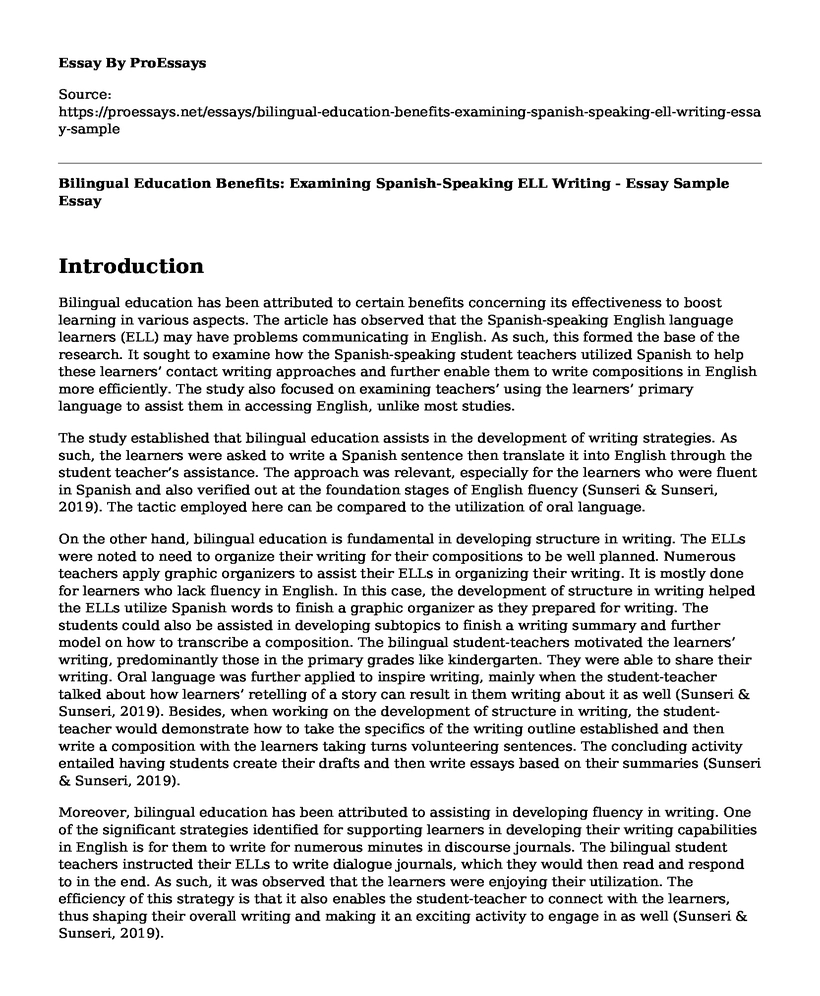Introduction
Bilingual education has been attributed to certain benefits concerning its effectiveness to boost learning in various aspects. The article has observed that the Spanish-speaking English language learners (ELL) may have problems communicating in English. As such, this formed the base of the research. It sought to examine how the Spanish-speaking student teachers utilized Spanish to help these learners’ contact writing approaches and further enable them to write compositions in English more efficiently. The study also focused on examining teachers’ using the learners’ primary language to assist them in accessing English, unlike most studies.
The study established that bilingual education assists in the development of writing strategies. As such, the learners were asked to write a Spanish sentence then translate it into English through the student teacher’s assistance. The approach was relevant, especially for the learners who were fluent in Spanish and also verified out at the foundation stages of English fluency (Sunseri & Sunseri, 2019). The tactic employed here can be compared to the utilization of oral language.
On the other hand, bilingual education is fundamental in developing structure in writing. The ELLs were noted to need to organize their writing for their compositions to be well planned. Numerous teachers apply graphic organizers to assist their ELLs in organizing their writing. It is mostly done for learners who lack fluency in English. In this case, the development of structure in writing helped the ELLs utilize Spanish words to finish a graphic organizer as they prepared for writing. The students could also be assisted in developing subtopics to finish a writing summary and further model on how to transcribe a composition. The bilingual student-teachers motivated the learners’ writing, predominantly those in the primary grades like kindergarten. They were able to share their writing. Oral language was further applied to inspire writing, mainly when the student-teacher talked about how learners’ retelling of a story can result in them writing about it as well (Sunseri & Sunseri, 2019). Besides, when working on the development of structure in writing, the student-teacher would demonstrate how to take the specifics of the writing outline established and then write a composition with the learners taking turns volunteering sentences. The concluding activity entailed having students create their drafts and then write essays based on their summaries (Sunseri & Sunseri, 2019).
Moreover, bilingual education has been attributed to assisting in developing fluency in writing. One of the significant strategies identified for supporting learners in developing their writing capabilities in English is for them to write for numerous minutes in discourse journals. The bilingual student teachers instructed their ELLs to write dialogue journals, which they would then read and respond to in the end. As such, it was observed that the learners were enjoying their utilization. The efficiency of this strategy is that it also enables the student-teacher to connect with the learners, thus shaping their overall writing and making it an exciting activity to engage in as well (Sunseri & Sunseri, 2019).
Another relevant to note is where there was a procedure of decreasing an oral recapping of a story into written form. The student-teacher finished sharing with the learners, then paired them and asked them to retell the same story. A document camera was then utilized to write every sentence in the composition that repeated the story. The learners were then asked to write a composition regarding their restating through the use of the composition of the teacher as an ideal. As such, this was a tactic to assist the ELL’s reply in English. By allowing students to speak in comprehensive sentences, it facilitated their writing. Thus, oral teaching of kids to be in a position to communicate their notions in complete sentences would eventually transfer into writing complete sentences. The leaners would then be prepared to write (Sunseri & Sunseri, 2019).
References
Sunseri, A. B., & Sunseri, M. A. (2019). The Write Aid for ELLs: The Strategies Bilingual Student Teachers Use to Help Their ELL Students Write Effectively. CATESOL Journal, 31, 117.
Cite this page
Bilingual Education Benefits: Examining Spanish-Speaking ELL Writing - Essay Sample. (2023, Aug 27). Retrieved from https://proessays.net/essays/bilingual-education-benefits-examining-spanish-speaking-ell-writing-essay-sample
If you are the original author of this essay and no longer wish to have it published on the ProEssays website, please click below to request its removal:
- The Effect of Mobile Learning on the Development of the Students Learning Behaviors and Performance
- Summary of Fine Motor Activities in Head Start and Kindergarten Classrooms
- Parental Care Essay Example
- Preschools and Daycare Centers - Essay Sample
- Paper Example on After-School Care: Ensuring Healthy Growth and Development
- Essay Example on Tutoring Students With ADHD: Challenges & Solutions
- Essay Example on Motor Learning: Information Processing Critical for Success







